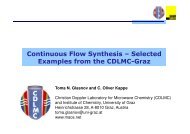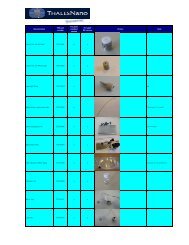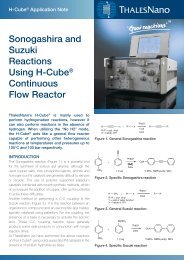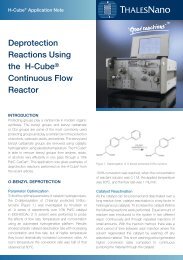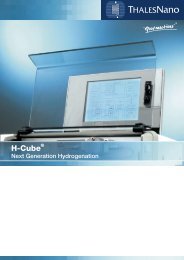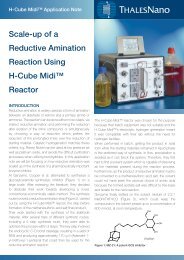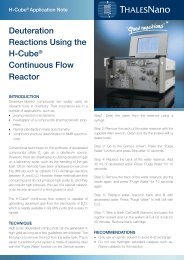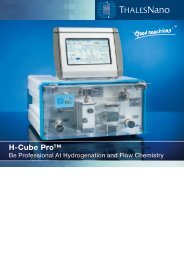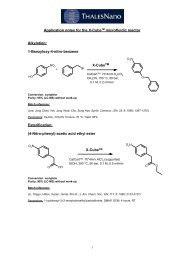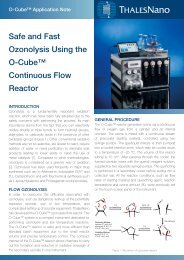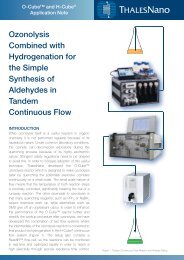Project: H-Cube Midiâ„¢ Product Update - ThalesNano
Project: H-Cube Midiâ„¢ Product Update - ThalesNano
Project: H-Cube Midiâ„¢ Product Update - ThalesNano
You also want an ePaper? Increase the reach of your titles
YUMPU automatically turns print PDFs into web optimized ePapers that Google loves.
<strong>Project</strong>:<br />
H-<strong>Cube</strong> Midi <strong>Product</strong> <strong>Update</strong><br />
„From mg to kg in one day”<br />
Richard Jones<br />
Záhony u. 7<br />
Budapest<br />
Hungary<br />
Tel.: +36-1-8808-500<br />
Fax: +36-1-8808-510<br />
E-mail: info@<strong>ThalesNano</strong>, Inc..com<br />
N.B. This Report is the property of <strong>ThalesNano</strong>, Inc. and may not be copied or distributed without permission of the<br />
author. All ideas and inventions expressed on this report including the names The H-<strong>Cube</strong>®, H-<strong>Cube</strong> Midi and<br />
MidiCart belong to <strong>ThalesNano</strong>, Inc. and are subject to patent and trademark applications.<br />
1
Table of Contents<br />
Executive Summary.................................................................... 3<br />
H-<strong>Cube</strong> Midi Overview .......................................................... 5<br />
Method Description .................................................................... 7<br />
Reaction Examples ..................................................................... 8<br />
Summary................................................................................... 11<br />
References................................................................................. 11<br />
N.B. This Report is the property of <strong>ThalesNano</strong>, Inc. and may not be copied or distributed without permission of the<br />
author. All ideas and inventions expressed on this report including the names The H-<strong>Cube</strong>®, H-<strong>Cube</strong> Midi and<br />
MidiCart belong to <strong>ThalesNano</strong>, Inc. and are subject to patent and trademark applications.<br />
2
Executive Summary<br />
The difficulties involved with scaling up reactions from laboratory to process scale are well<br />
known. 1 Reaction pathways are often designed in laboratories on a small scale. Laboratory<br />
experiments carried out in test tubes or small flasks produce the required chemical or product, but<br />
may not indicate the side effects of the reaction. These include formation of by-products and<br />
release of gases or vapours which may be toxic or flammable. Heat releases may be absorbed by<br />
the equipment or surroundings and go unnoticed. In the laboratory, reactions are carried out in<br />
glass vessels, while in scale-up other materials may be used which may result in unexpected<br />
reactions or problems including catalyst and inhibition effects. The time taken for the reaction to<br />
take place is often extended significantly with scale up. This change in thermochemistry can lead<br />
to formation of other products. Reagents or solvents used on a small scale may carry too much of<br />
a health risk when used in larger amounts. The above side effects may lead to disastrous<br />
consequences if not evaluated fully. These include fire and explosion hazards. Indeed, methods<br />
and technologies are missing that allow rapid transfer from the research level to process<br />
development without time-consuming adaptation and optimization of methods from the<br />
laboratory scale to production plant scale.<br />
The advent of flow technology can overcome these restrictions and allow rapid preparation of<br />
compounds with minimum workup. Reactions are carried out on a small scale but can be scaled<br />
up by performing the reactions in parallel. This has a number of advantages. The<br />
thermochemistry of the reaction doesn’t change, so the reaction result will be constant. The heat<br />
production is highly controllable meaning many hazardous reagents that were prohibited<br />
previously may now be used in a safe controlled manner. Furthermore, reagents or compounds<br />
only undergo short reaction times and are then eluted into a collection vial, so further reaction<br />
with starting materials or thermal decomposition is unlikely. Since <strong>ThalesNano</strong>’s reactors utilize<br />
N.B. This Report is the property of <strong>ThalesNano</strong>, Inc. and may not be copied or distributed without permission of the<br />
author. All ideas and inventions expressed on this report including the names The H-<strong>Cube</strong>®, H-<strong>Cube</strong> Midi and<br />
MidiCart belong to <strong>ThalesNano</strong>, Inc. and are subject to patent and trademark applications.<br />
3
continuous flow any amount of material can be produced by leaving the reaction running until the<br />
required product is produced.<br />
The main advantages of the flow-through approach, such as facile automation, reproducibility,<br />
safety and process reliability, are yet to be fully exploited for scale up. 2<br />
The H-<strong>Cube</strong>® was a break-through for flow-reactor technology as well as a significant<br />
advancement on current hydrogenation technology 3 . The H-<strong>Cube</strong>® has led the way for flow-<br />
reactor technology by being the first commercially successful micro-flowreactor that has become<br />
quickly adopted as the prefered method for hydrogenation. A flow process coupled with high<br />
pressure endogenous production of hydrogen from water electrolysis and proprietary catalyst<br />
cartridges has meant that hydrogenation is now safer and reaction times decreased significantly.<br />
The only limit, so far, has been scale with a maximum potential output of 100 g per day.<br />
The H-<strong>Cube</strong> Midi represents the first step in the <strong>ThalesNano</strong>, Inc.’s development towards<br />
process scale flow hydrogenation. Utilizing current H-<strong>Cube</strong>® technology, the H-<strong>Cube</strong> Midi<br />
seeks to increase the capacity of the present H-<strong>Cube</strong>® to 500 g per day without compromising<br />
efficiency and safety. The H-<strong>Cube</strong> Midi will allow users of the H-<strong>Cube</strong>® to scale up reactions<br />
and achieve the same result.<br />
N.B. This Report is the property of <strong>ThalesNano</strong>, Inc. and may not be copied or distributed without permission of the<br />
author. All ideas and inventions expressed on this report including the names The H-<strong>Cube</strong>®, H-<strong>Cube</strong> Midi and<br />
MidiCart belong to <strong>ThalesNano</strong>, Inc. and are subject to patent and trademark applications.<br />
4
H-<strong>Cube</strong> Midi Overview<br />
� Capable of producing from 150-500 g per day in a standard laboratory - no special<br />
precautions regarding explosion proof rooms required<br />
� The maximum flow rate is 25 mL/min at elevated temperature and pressure up to 150°C<br />
and 100 bars<br />
� High-quality, robust design, easy to handle and operate<br />
� On-demand internal hydrogen generation, requiring only a source of distilled water<br />
Single/repeat-use, replaceable, MidiCart catalyst column module, conveniently located<br />
at the front of the device, enabling rapid and easy operator access<br />
� A number of safety features including hydogen leak detector<br />
� Smallest possible footprint, maximising available bench space<br />
� Full system Touch Screen control and monitoring<br />
N.B. This Report is the property of <strong>ThalesNano</strong>, Inc. and may not be copied or distributed without permission of the<br />
author. All ideas and inventions expressed on this report including the names The H-<strong>Cube</strong>®, H-<strong>Cube</strong> Midi and<br />
MidiCart belong to <strong>ThalesNano</strong>, Inc. and are subject to patent and trademark applications.<br />
5
Ease of Operation<br />
The H-<strong>Cube</strong> Midi uses a Touch-Screen interface. All of the parameters that control and<br />
monitor the H-<strong>Cube</strong> Midi functions are input and displayed using this touch screen. To<br />
monitor the the system using a computer interface (requires additional software) is possible.<br />
The H-<strong>Cube</strong> Midi may be used safely in any fumehood environment, while its minimal<br />
footprint maximizes available fume hood space. The H-<strong>Cube</strong> Midi employs a number of high<br />
pressure liquid chromatography (HPLC) connections, pumps and delivery systems. The<br />
maintenance of the instrument is therefore simple for those users already experienced with HPLC<br />
technology and easy to teach to those users who have no such experience.<br />
Safety Features<br />
The Touch Screen displays and controls essential reaction parameters, while in-built<br />
detectors safely monitor every aspect of the H-<strong>Cube</strong> Midi function:<br />
� A detector shuts down the device in the event of a hydrogen leak or blockage.<br />
� No external hydrogen storage such as gas cylinders necessary.<br />
� No direct catalyst handling, pre- or post-reaction<br />
� Minimum exposure to hazardous reactants, such as radio-labelled or mutagenic<br />
intermediates<br />
N.B. This Report is the property of <strong>ThalesNano</strong>, Inc. and may not be copied or distributed without permission of the<br />
author. All ideas and inventions expressed on this report including the names The H-<strong>Cube</strong>®, H-<strong>Cube</strong> Midi and<br />
MidiCart belong to <strong>ThalesNano</strong>, Inc. and are subject to patent and trademark applications.<br />
6
Method Description<br />
The H-cube Midi system works through the hydrogenation of a continuous flow of substrate.<br />
The substrate is flowed through the system using an automatically controlled piston-pump at<br />
flow-rates up to 50 mL/min. Once entering the H-<strong>Cube</strong> Midi reaction line, the flow of substrate<br />
is mixed with a continuous flow of hydrogen. The hydrogen is created by the electrolysis of water<br />
within an electrolytic cell. The electrolytic cell is based on the original H-<strong>Cube</strong>® cell, but has<br />
been modified for a larger output of hydrogen. The hydrogen gas and a solution of the reactant<br />
are mixed, pre-heated and transferred to a disposable catalyst cartridge (MidiCart) that is<br />
preloaded with the required heterogeneous catalysts.<br />
The MidiCart is a stainless steel tube packed with a heterogeneous catalyst and a filter at either<br />
end. The filter prevents any of the catalyst from leaking and allows the catalyst to be recycled at<br />
the end of each experiment. The substrate-hydrogen mixture reacts on the catalyst, converts to<br />
product and then flows out of the cartridge. The high ratios of catalyst compared to the substrate-<br />
hydrogen mixture ensure high mass transfer rates and therefore high rates of reaction. The<br />
MidiCart design has been enlarged to cope with higher flow rates and concentrations. The<br />
product then flows out of the cartridge and is collected in a vial or flask. In most reactions the<br />
only work-up required is the evaporation of solvent.<br />
The continuous flow of reaction mixture out of the device allows the operator to carry out on-the-<br />
spot analysis of the resulting reaction mixture. Reaction parameters can be easily adjusted using a<br />
touch-screen interface in order to achieve a better product yield. The ability to continuously<br />
monitor production is vital to ensure that the purity of product is maintained throughout the scale<br />
up process. Fractions of product may be collected to ensure that contamination of product through<br />
starting material doesn’t transpire because of catalyst deactivation or poisoning.<br />
N.B. This Report is the property of <strong>ThalesNano</strong>, Inc. and may not be copied or distributed without permission of the<br />
author. All ideas and inventions expressed on this report including the names The H-<strong>Cube</strong>®, H-<strong>Cube</strong> Midi and<br />
MidiCart belong to <strong>ThalesNano</strong>, Inc. and are subject to patent and trademark applications.<br />
7
Reaction Examples<br />
The following is a series of validation reactions to test the applicability and the capacity of<br />
the system.<br />
Materials and General Methods<br />
For HPLC runs, a LaChrom system (Merck-Hitachi) connected to an autosampler and a fraction<br />
collector based on a Cavro RSP 9000 (Cavro Scientific Instruments, Inc.) robotic workstation<br />
was used. The column type used was Purospher STAR RP-18 endcapped, 3µm, 30x4 mm. The<br />
detection wavelengths were 220 or 254 nm. MS data were collected on a ZQ singlequad<br />
(Micromass-Waters) mass spectrometer using an APCI interface.<br />
General Experimental<br />
Hydrogenation of benzaldehyde to form benzyl alcohol<br />
Benzaldehyde (71g, 0.67 moles) was dissolved in methanol (1911 mL, 0.35M). A MidiCart<br />
containing 10% Pd/C was loaded into the H-<strong>Cube</strong> Midi. Pure methanol was pumped through<br />
the H-<strong>Cube</strong> Midi at a flow-rate of 10 mL/min. The temperature and pressure were set to 40°C<br />
and 70 bar respectively. Once the H-<strong>Cube</strong> Midi was producing hydrogen at the set temperature<br />
and pressure, the inlet line was switched from the solvent to the benzaldehyde solution. After 3<br />
hours pure solvent was run though the system for 10 minutes to wash any residual compound off<br />
the catalyst. Evaporation of the solvent yielded the product (52 g, 72% yield).<br />
The rest of the examples are carried out as above. A summary of their results are given in the<br />
Table below. The reactions were carried out on a MidiCart either with internal measurements<br />
of 9.5 mm x 90 mm or 20 mm * 86 mm<br />
N.B. This Report is the property of <strong>ThalesNano</strong>, Inc. and may not be copied or distributed without permission of the<br />
author. All ideas and inventions expressed on this report including the names The H-<strong>Cube</strong>®, H-<strong>Cube</strong> Midi and<br />
MidiCart belong to <strong>ThalesNano</strong>, Inc. and are subject to patent and trademark applications.<br />
8
O 2N<br />
Starting<br />
Material<br />
N<br />
H<br />
HN<br />
OH<br />
O<br />
O<br />
O<br />
O<br />
O<br />
OH<br />
Ph<br />
H 2N<br />
<strong>Product</strong> Reaction Conditions Amount<br />
Processed/<br />
Time<br />
N<br />
H<br />
OH<br />
OH<br />
OH<br />
O<br />
OH<br />
NH2<br />
Flow-rate: 10 mL/min<br />
Temperature: 40°C<br />
Pressure: 70 bar<br />
Solvent: methanol<br />
Catalyst: 10% Pd/C (2,9 g)<br />
Concentration: 0.35 M<br />
Flow-rate: 25 mL/min<br />
Temperature: 40°C<br />
Pressure: 70 bar<br />
Solvent: methanol<br />
Catalyst:10% Pd/C (10,84 g)<br />
Concentration: 0.35 M<br />
Flow-rate: 30 mL/min<br />
Temperature: 30°C<br />
Pressure: 30 bar<br />
Solvent: methanol<br />
Catalyst: 10% Pd/C (2,81 g)<br />
Concentration: 0.05 M<br />
Flow-rate: 10 mL/min<br />
Temperature: 90°C<br />
Pressure: 10 bar<br />
Solvent: ethanol<br />
Catalyst: Raney Cu (17,4 g)<br />
Concentration: 0.2 M<br />
Flow-rate: 10 mL/min<br />
Temperature: 60°C<br />
Pressure: 50 bar<br />
Solvent: ethanol<br />
Catalyst: 10% Pd/C (3,1 g)<br />
Concentration: 0.05 M<br />
N.B. This Report is the property of <strong>ThalesNano</strong>, Inc. and may not be copied or distributed without permission of the<br />
author. All ideas and inventions expressed on this report including the names The H-<strong>Cube</strong>®, H-<strong>Cube</strong> Midi and<br />
MidiCart belong to <strong>ThalesNano</strong>, Inc. and are subject to patent and trademark applications.<br />
9<br />
71 g in 3<br />
hours<br />
74,2 g in 80<br />
min<br />
46,2 g in 3<br />
hours<br />
92 g in 6<br />
hours<br />
13.9 g in 1.5<br />
hours<br />
Calc.<br />
Amount<br />
for 8<br />
hours<br />
Yield<br />
190 g 72%<br />
445,2 g 74%<br />
123 g 90%<br />
122.66 g 82%<br />
74 g 95%
Optimisation of the conditions with H-<strong>Cube</strong> Midi can be carried out very quickly and<br />
effectively.<br />
The optimisation of the reduction of methyl-4-nitrobenzoate was completed within a few hours<br />
by scanning the concentration and the flow rate at a set temperature.<br />
Conversion (%)<br />
120<br />
100<br />
80<br />
60<br />
40<br />
20<br />
0<br />
O<br />
NO 2<br />
OCH 3<br />
N.B. This Report is the property of <strong>ThalesNano</strong>, Inc. and may not be copied or distributed without permission of the<br />
author. All ideas and inventions expressed on this report including the names The H-<strong>Cube</strong>®, H-<strong>Cube</strong> Midi and<br />
MidiCart belong to <strong>ThalesNano</strong>, Inc. and are subject to patent and trademark applications.<br />
H 2<br />
10<br />
O<br />
NH 2<br />
0 5 10 15 20 25<br />
Flow rate (mL/min)<br />
OCH 3<br />
0,2M<br />
0,17M<br />
0,15M<br />
0,12M<br />
0,1M<br />
Parameters: 5% Pd/C, P: 70 bar, T: 70 o C, Flow rate: 20-2,5 mL/min, C: 0,2-0,1 M
Summary<br />
The H-<strong>Cube</strong> Midi has managed to increase the throughput of the original H-<strong>Cube</strong> significantly<br />
while maintaining the safety benefits. High yield and conversion were maintained in every<br />
example despite the increase in flow-rate. Preliminary experiments with larger columns gave<br />
throughputs up to 500 g/day. Once the H-<strong>Cube</strong> Midi is released it will represent a bench mark<br />
in flow scale-up technology.<br />
References<br />
1. RSC environment, health and safety committee note on Safety Issues in the Scale up of<br />
Chemical Reactions, Version 1/3/99.<br />
2. G. Jas, A. Kirchning, Chem. Eur. J. 2003, 9, 5708-5723; b) A. Kirchning, W. Solodenko,<br />
3.<br />
K. Mennecke, Chem. Eur. J. 2006, 12, 5972-5990; c) J. M. Woodley, M. D. Lilly, in<br />
Applied Biocatalysis, (Eds.: J. M. S. Cabral, D. Best, L. Boros, J. Tramper), Harwood<br />
Academic, London, 1994, pp. 371-393.<br />
3.a. Ritter, S., Natural product synthesis on the fly. Multistep continuous reaction shows the<br />
power of automated flow synthesis, Chemical&Engineering News; 2006; 84(10); 17<br />
3.b. Desai, B. and Kappe, O., heterogeneous hydrogenation reactions using a continuous flow<br />
high pressure device, J.Combi. Chem.; 2005; 7; 5; 641-643<br />
3.c. Saaby, S., Knudsen, K.R., Ladlow, M., Ley, S.V., The use of a continuous flow reactor<br />
employing a mixed hydrogen-liquid floe stream for the efficient reduction of imines to<br />
amines; Chem. Commun.; 2005; 23; 2909-11<br />
3.d. Spadoni, S., Jones, R., Urge, L. and Darvas, F.; The recent advancement of hydrogenation<br />
technology and their implications for drug discovery research; Chem. Today,<br />
January/February 2005; 36-39<br />
N.B. This Report is the property of <strong>ThalesNano</strong>, Inc. and may not be copied or distributed without permission of the<br />
author. All ideas and inventions expressed on this report including the names The H-<strong>Cube</strong>®, H-<strong>Cube</strong> Midi and<br />
MidiCart belong to <strong>ThalesNano</strong>, Inc. and are subject to patent and trademark applications.<br />
11
3.e. Jones, R., Godorhazy, L., Szalay, D., Urge, L., Darvas, F., A novel method for high-<br />
throughput reduction of compounds through automated sequential injection into a<br />
continuous-flow microfluidic reactor, QSAR Comb. Sci., 2005, 24(6); 722-727<br />
3.f. Spadoni, C, Jones, R., Urge, L., Darvas, F., Scaling up and validation of hydrogenation<br />
reactions using a continuos-flow microfluidics-based reactor, H-<strong>Cube</strong>; Chem. Today;<br />
February/March 2006; 38-41<br />
3.g. Szollosi, Gy., Herman, B., Fulop, F., and Bartok, M.; Continuous enantioselective<br />
hydrogenation of activated ketones on a pt-cd chiral catalyst: use of H-cube reactor system,<br />
Reaction Kinetics and Catalysis Letters, 2006, 88(2), 391-398<br />
3.h. Franckevicius, V, Knudsen, K.R., Ladlow, M., Longbottom, D.A. and Ley, S.V.;<br />
Practical Synthesis of (S)-Pyrrolidin-2-yl-1H-tetrazole, Incorporating Efficient Protecting<br />
Group Removal by Flow-reactor Hydrogenolysis, Synlet., 2006, 889-892<br />
3.i. Baxendale, I.R., Griffiths-Jones, C.M., Ley, S.V. and Tranmer, G.K., Preparation of the<br />
Neolignan Natural <strong>Product</strong> Grossamide by a Continuous Flow Process, Synlett, 2006, 427-<br />
430<br />
3.j. Baxendale, I.R., Deeley, J., Griffiths-Jones, C.M., Ley, S.V., Saaby, S. and Tranmer, G.;<br />
A Flow Process for the Multi-Step Synthesis of the Alkaloid Natural <strong>Product</strong><br />
Oxomaritidine: A New Paradigm for Molecular Assembly, J. Chem. Soc., Chem. Commun.,<br />
2006, 2566-2568.<br />
3.k. Desai, B., Dallinger, D., Kappe, C.O., Microwave-Assisted Solution Phase Synthesis of<br />
DihydropyriMidine C5 Amides and Esters, Tetrahedron, 2006, 62, 4651-4664<br />
3.l. Koppotz, M., Eis, K., Automated Medicinal Chemistry, Drug Discovery Today, 2006,<br />
11(11/12), 561-568<br />
3.m. Microfluidics in commercial applications; an industry perspective, Lab Chip, 2006, 6,<br />
1118-1121<br />
N.B. This Report is the property of <strong>ThalesNano</strong>, Inc. and may not be copied or distributed without permission of the<br />
author. All ideas and inventions expressed on this report including the names The H-<strong>Cube</strong>®, H-<strong>Cube</strong> Midi and<br />
MidiCart belong to <strong>ThalesNano</strong>, Inc. and are subject to patent and trademark applications.<br />
12



